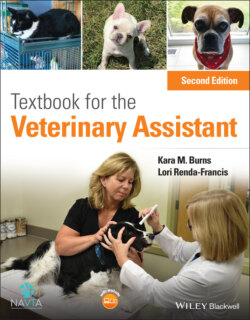Читать книгу Textbook for the Veterinary Assistant - Lori Renda-Francis - Страница 65
Subtle signs
ОглавлениеAvoiding eye contact
Blinking slowly or squinting
Closing mouth tightly
Dilated pupils
Licking lips
Lifting paws
Pulling mouth back
Pacing
Panting
Self‐grooming
Shifting eyes
Staying close to the owner
Tail flicking/thrashing (feline)
Taking treats roughly, being pickier than usual about treats, or refusing treats
Unable to settle down
Yawning
Every member of the health‐care team should be able to recognize signs of a relaxed or stressed patient, as this is critical to establishing a Fear Free environment. As noted above, some signs may be subtle, and the owner will not recognize these as being associated with FAS. It is imperative that the health‐care team continually assesses the patient while at the veterinary hospital. The patient is actually communicating – we just need to be cognizant of the signs. Be aware of the patient’s body language and what it is conveying. Being aware of the subtle signs will allow the team to adjust their behaviors accordingly to prevent the patient from escalating. Adjusting behavior may be simple – such as pausing briefly to let the patient acclimate to your touch before proceeding.
Remember to keep an emotional record alongside the medical record and detail what worked for the patient. This will help future visits to be less stressful for all involved. Examples of information to be captured include:
types of rewards that were effective
where the patient preferred to be examined
the way a procedure was performed.
This way, when the patient returns for a hospital visit, the team will have an initial plan for care and the pet owner will be impressed with your thoughtfulness.
In addition, the veterinary team should use a considerate approach. This approach involves the interaction between the veterinary team, the patient, and input from the environment while veterinary care is being administered. Creating this relaxing and satisfying experience involves establishing the environment keeping the patient and client in mind. The veterinary team should put themselves in the pet and owner’s “shoes or paws.” Minimize the stress – provide nonslip surfaces for pets to stand on, include calming scents and/or pheromones, use calming sounds, reducing odor, etc. These all help in providing a relaxing and calming environment for pets and owners alike.
Figure 4.10 Fear and stress in (a) cats and (b) dogs.
Gentle control is another tool from the Fear Free toolbox. It incorporates how the veterinary team comfortably and safely positions the patient to allow the administration of veterinary care with minimal restraint. We discuss restraint above in this chapter, as we know it is frequently the restraint that frightens and stresses patients. As mentioned above, using distraction techniques while providing gentle guidance and support to a patient allows many procedures to be performed safely and with slight restraint and fewer team members.
For a greater understanding of Fear Free and the initiative which aims to make veterinary visits less stressful, visit https://fearfreepets.com/
